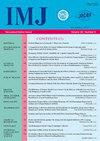CHANGES IN SMALL INTESTINE MICROFLORA IN PATIENTS WITH ACUTE INTESTINAL OBSTRUCTION
Q4 Medicine
引用次数: 0
Abstract
Among urgent surgical diseases of abdominal cavity, an acute intestinal obstruction is the most difficult to be diagnosed and treated. Leading factor, determining the development of pathophysiological processes is considered to be the progressive manifestations of enteric insufficiency syndrome, resulting in intestinal barrier impairment, negative changes in ecology of intestinal flora, increased endotoxins. To identify the small intestine microflora in acute intestinal obstruction and determine the role of dysbiotic disorders in clinical manifestations of main pathological process, a study was conducted in 60 patients with mechanical intestinal obstruction. The small intestine has a relatively rare microflora, consisting mainly of gram−positive facultative aerobic microorganisms, streptococci, lactobacilli. The distal ileum in nearly 30−55 % of healthy people contains scanty microflora, and yet the flora of this area differs from the microbial population of the higher gastrointestinal tract due to higher concentration of gram−negative bacteria. Optional−anaerobic coliform bacilli, anaerobic bifidobacteria and fusobacteria, bacteroids, the number of which starts exceeding the one of gram−positive species, are presented in significant quantities. Distal to the ileocecal valve there are significant changes in the microflora quantitative and species composition. Obligatory anaerobic bacteria become the predominant part of microflora, exceeding the number of aerobic and facultative anaerobic bacteria. The bacterial flora in different parts of gastrointestinal tract has its own specifics and is quite constant, as a result of the interaction of many factors, regulating the bacterial population in small intestine. The most important among them are: acidity of gastric juice, normal peristaltic activity of the intestine, bacterial interactions and immune mechanisms. Disorders of the intestine motor and evacuation function with its obstruction lead to slow passage of the chyme and contamination of the upper gastrointestinal tract with new types of microbes. There is a syndrome of small intestine excessive colonization, which means an increased concentration of bacterial populations in it, similar in species composition to the colon microflora. Pathological intra−intestinal contents become a source of endogenous infection and re−infection of the patient, leads to internal digestive disorders, which is manifested by syndrome of malabsorption of proteins, carbohydrates and vitamins. Key words: acute intestinal obstruction, small intestinal microflora, conditionally pathogenic microorganisms, intestinal biocenosis.急性肠梗阻患者小肠菌群的变化
在急症腹腔外科疾病中,急性肠梗阻是最难诊断和治疗的。主导因素,决定病理生理过程的发展被认为是肠功能不全综合征的进行性表现,导致肠屏障受损,肠道菌群生态负性改变,内毒素增加。为确定急性肠梗阻患者小肠菌群,确定生态失调在主要病理过程临床表现中的作用,对60例机械性肠梗阻患者进行了研究。小肠有相对罕见的菌群,主要由革兰氏阳性兼性需氧微生物、链球菌、乳酸杆菌组成。近30 - 55%的健康人的远端回肠中含有很少的微生物群,但由于革兰氏阴性菌的浓度较高,该区域的菌群与上消化道的微生物群不同。可选的-厌氧大肠菌群、厌氧双歧杆菌和梭杆菌、类细菌的数量开始超过革兰氏阳性菌的数量。回盲瓣远端菌群数量和种类组成发生显著变化。专性厌氧菌数量超过好氧和兼性厌氧菌数量,成为微生物区系的主要组成部分。胃肠道不同部位的细菌菌群有其自身的特点,并且在多种因素的相互作用下具有相当的稳定性,调节着小肠内的细菌种群。其中最重要的是:胃液的酸度、肠道的正常蠕动活动、细菌的相互作用和免疫机制。肠道运动和排泄功能紊乱及其阻塞导致食糜通过缓慢和新型微生物污染上胃肠道。有一种小肠过度定植综合症,这意味着其中细菌种群的浓度增加,在物种组成上与结肠微生物群相似。病理性肠内内容物成为患者内源性感染和再感染的来源,导致内部消化功能紊乱,表现为蛋白质、碳水化合物和维生素吸收不良综合征。关键词:急性肠梗阻,小肠菌群,条件致病性微生物,肠道微生物病
本文章由计算机程序翻译,如有差异,请以英文原文为准。
求助全文
约1分钟内获得全文
求助全文
来源期刊

International Medical Journal
医学-医学:内科
自引率
0.00%
发文量
21
审稿时长
4-8 weeks
期刊介绍:
The International Medical Journal is intended to provide a multidisciplinary forum for the exchange of ideas and information among professionals concerned with medicine and related disciplines in the world. It is recognized that many other disciplines have an important contribution to make in furthering knowledge of the physical life and mental life and the Editors welcome relevant contributions from them.
The Editors and Publishers wish to encourage a dialogue among the experts from different countries whose diverse cultures afford interesting and challenging alternatives to existing theories and practices. Priority will therefore be given to articles which are oriented to an international perspective. The journal will publish reviews of high quality on contemporary issues, significant clinical studies, and conceptual contributions, as well as serve in the rapid dissemination of important and relevant research findings.
The International Medical Journal (IMJ) was first established in 1994.
 求助内容:
求助内容: 应助结果提醒方式:
应助结果提醒方式:


